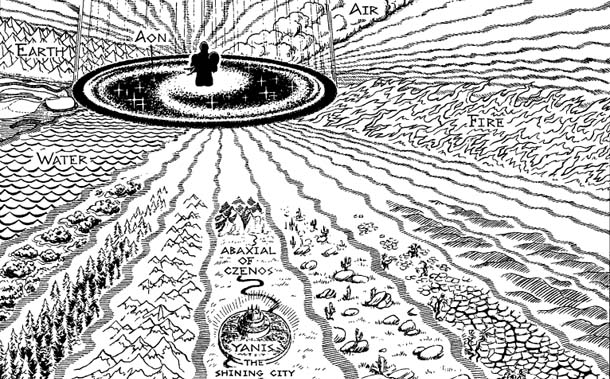January 30, 2017
The Lone Wolf Series

This part three of a tribute to Joe Dever. You can read part one here and you can read part two here. In this post I’d like to discuss the Lone Wolf (LW) series as a whole. Fair warning, there may be a few minor spoilers.
Writing Style and Immediacy
I love Joe Dever’s writing. A single read-through of a LW book does not involve an immense number of words (If you happen to have any idea how many words are in a typical read-through of a LW book, please let me know in the comments!). And yet, he accomplishes a great deal with a small amount.
Along the same lines, I always felt that the LW series does a great job of pulling the reader into the story. Part of this is due to the use of second person (for more on that topic, see my post on point of view in interactive fiction), but overall I think it’s the writing that immerses you so well. Every time he describes the way Lone Wolf pulled his bowstring back to his lips with the calm and cool of a Kai Master in battle, I would feel that schoolboy giddiness. I felt like I was the up-close and sole viewer of an action movie where I was calling all the shots. This sort of immersion is something we’d like to try to reproduce in Harrowing Adventures.
Serial Adventure
Another thing that made LW unique, especially for its time, is the fact that all of the books together tell one long story (or a “campaign” as its known in roleplaying circles). Neither Choose Your Own Adventure nor Fighting Fantasy did this at the time. In doing this, LW was following in the footsteps not only of RPG’s like Dungeons and Dragons, but also in the footsteps of the even older pulp magazines and serial radio shows of the 1930’s and 1940’s. You can get this vibe just from considering the titles of the books, which borrows from the old serial template of “The _____ of _____”, such as “The Jungle of Horrors”, “The Cauldron of Fear”, “The Chasm of Doom”, and so on. If those titles remind you of “The Raiders of the Lost Ark”, “The Temple of Doom”, and “The Kingdom of the Crystal Skull”, that’s because they are both styled after the same pulp serials from many decades ago.
In order to create a serial adventure, the LW series allowed you to carry your character over from book to book and watch him grow in power. This ties in with the epic scope of the series, which I’ll get to next, but I do think Joe Dever very cleverly adopted one of the tactics that make tabletop roleplaying games so much fun: the ability to stay with one character for a long time and watch that character grow and develop. As a roleplayer myself, I know how much we can get attached to our characters. After years of playing a character, it becomes like an alter-ego, almost an extension of yourself. I think Lone Wolf did the same thing. Again, this is partly due to the use of second person, but I primarily believe it’s because you get to play the same character throughout all 20 books of the series and watch him develop from a simple monastery initiate into a dimension-hopping Supreme Kai Master battling gods and demi-gods.
Epic Scope
Perhaps the biggest thing that I enjoy about the series is its epic scope. And moreover, I love the way Joe Dever draws you into his world of Magnamund. He accomplishes this with a simple but brilliant tactic: the books are written such that the reader’s knowledge of the world of Magnamund grows in parallel with Lone Wolf’s knowledge of Magnamund. That way, you (the reader) share with Lone Wolf (the protagonist) the thrill of discovering new beings and new realms. (For more musings on the similar-but-different experiences of reader and protagonist in interactive fiction, checkout my blog post on that topic.)
To give some examples, consider the following. In LW1, the entire book takes place within a small radius on the map, between the Monastery and Holmgard. In LW2 you venture forth from Sommerlund, all the way to the neighboring capital city of Durenor. Then you head north to the frozen wastes in LW3 and south to Ruanon in LW4, before going to the “far east” (literally and figuratively) in LW5. In LW6 you travel so far afield people haven’t heard of you and they treat you like a foreigner.
Even by the end of LW12, you’ve really only just explored your own northeastern corner of the continent. In the Grandmaster series (LW13 – LW20) you start broadening the scope even more… traveling to Darke in the distant west and Ixia in the far northwest. And LW18 gives you a nice grand tour in which you revisit many of these lands you’ve explored previously.
Finally, by LW19 and LW20, Magnamund alone isn’t enough and you are planet-hopping and skipping around through dimensions. (And if you want to take it post-LW20, the New Order series allows you to explore the southern continent of Magnamund too).
I love the epic scope of all this, and the reader is taken along for the ride since neither you nor the protagonist have much knowledge of these far-flung lands until he actually visits them in the story. As both the reader and the protagonist, at the outset you hardly know your own countryside (the mere trip from the Monastery to Holmgard is an adventure in itself and occupies the entirety of LW1), and by the end the entire northern continent of Magnamund feels like a familiar and well-traveled place. In my opinion, the broadening scope of the series was masterfully done.
Game Balance and the Sommerswerd Dilemma
As much as I love the LW series, it wasn’t without its flaws, of course. One of the more challenging issues in running any roleplaying game is game balance; that is, keeping it challenging without it being too challenging. Early in the series (in LW2), Joe Dever introduced a powerful magic sword, the Sommerswerd. But not everyone read LW2, and so not everyone had that sword. This meant that later in the series Joe had to create two versions of each encounter with the major villains, one for players that have the Sommerswerd and one for players that didn’t. Otherwise, if he’d just written one version of the encounter, it would’ve been too challenging for those lacking the sword and too easy for those that had it. So by introducing the Sommerswerd, he cornered himself into making two versions (a low-powered and high-powered one) of each major enemy (of course, such an issue is no worry whatsoever in a computer game, but when it’s printed in good old ink and paper then you have to create adaptability in other ways). I’ve heard some LW fans refer to this as “Sommerswerd guilt”, speculating about Joe’s feelings on introducing a powerful item early on. The dual-encounter issue also lead to a little bitterness on the part of those that did have the sword because they felt they were punished for having it (especially in the case of fighting Zakhan Kimah in LW9 who, due to game balance problems, is nigh unbeatable when you have the sword but not so bad when you don’t… and that doesn’t make a lot of sense).
Almost every tabletop Gamemaster has experienced this same thing. It’s fun to let your players seek out and acquire treasures, but then you pay the price later because your players quickly become overpowered and it becomes harder to challenge them. So as the Gamemaster you might look to find ways to “de-power” them. Joe Dever tried this too. In LW2 you abandon your shield or else drown. In LW7 you must lose your backpack in order to escape the castle at the end and therefore (speaking from personal experience) lose all of the healing potions and other knicknacks that you’ve been hoarding and schlepping around since LW1 in preparation for those future dire boss battles. In LW8 a bowyery shop owner tries to steal your Silver Bow of Duadon and ultimately the special bow ends up getting destroyed. Perhaps there was some “Silver Bow guilt” as well? He did, after all, introduce this item in LW6, so virtually at the same time as he introduced bows to the game rules he gave us a special one. Don’t get me wrong, I love acquiring items like the Sommerswerd and Silver Bow just like any other player, but such things tend to introduce game balance issues for the author.
Story Pruning and Insta-Death
Another thing that any interactive fiction writer can identify with is the issue of how to prune the branches of the story to keep it at a manageable size. If you don’t do some occasional pruning, the complexity of the story rapidly grows out of control. One way to prune is to combine branches together by funneling the story towards certain milestones. The LW series certainly did this, and did it well. Another way to prune is to just end the branch, sometimes seemingly prematurely, because you just can’t realistically develop every possible thread to its ultimate conclusion. This phenomenon has been labeled “insta-death”, because it’s the type of story ending that is abrupt and usually leads to an unexpected death. (For a really interesting approach to dealing with pruning and insta-death, check out my blog article on Netflix’s Bandersnatch).
LW had its share of insta-death scenes. Perhaps the most infamous of these is the one at the end of LW13 where, post-climax and with success nearly within your grasp, a single random roll means there’s always a 10% chance that the story might end for you right then and there, and there’s no way around it (I’m referring to the bridge scene). Another example is in LW11 when you are sneaking up on the city of Thas and the chariots that are sent to intercept you will insta-kill you if you attempt to fight them with a bow but won’t insta-kill you if you choose to fight them with a hand weapon (again, that doesn’t make a lot of sense… isn’t the ranged weapon typically a safer choice, especially against chariots?)
Perhaps the most infamous pitfall in the Lone Wolf series was Shamath’s riddle in LW16. Conspiracy theories abounded about the true way to solve the riddle (or some even proposed that, because Shamath is evil, the riddle was supposed to be unsolvable) until Joe Dever eventually announced that it was a flawed problem. For more about that riddle, I have an entire blog post devoted to it.
What are your thoughts on the Lone Wolf series as a whole? What did it to do well? What were its flaws? Please share your thoughts in the comments below!
In the next and final blog entry about Lone Wolf, I’ll discuss the individual books themselves and my favorite scenes from the series.

